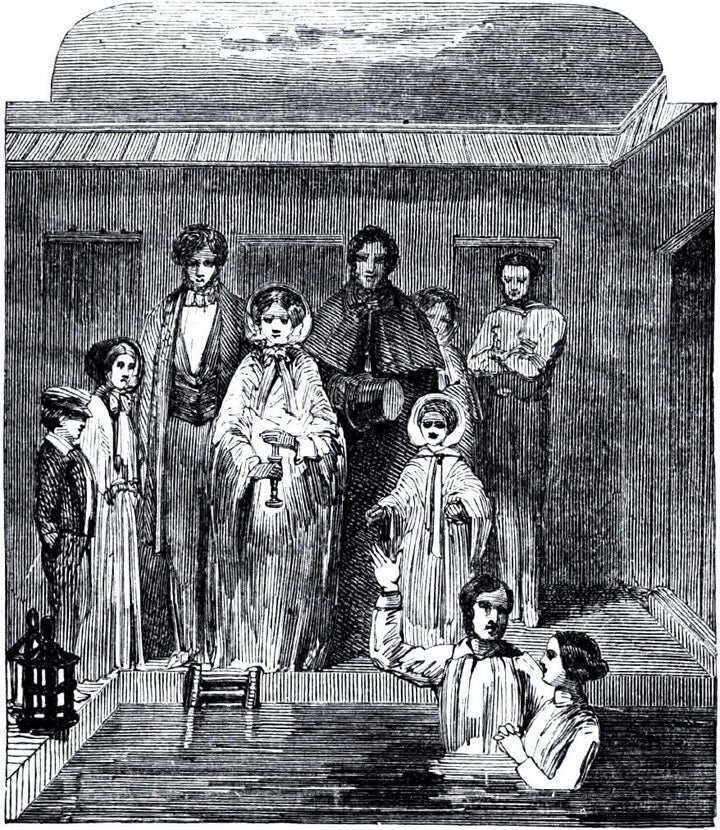
Mormons are known for many things, from their love of corporate attire and organization, to their almost uncanny cheeriness, to their scandalous history of polygamy. They are also known as the chief sleuths of genealogy in the modern world. There is a purportedly dark side to their interest in the personal side of world history: the rituals performed for deceased individuals identified through genealogical research. Best known among these rituals is a version of the familiar Christian rite of baptism. Called "baptism for the dead," Mormons have performed such baptisms since their founding prophet introduced the practice on the banks of the Mississippi in the early 1840s. In this rite, Mormons receive baptism "for and in behalf of" a deceased individual and are themselves immersed, just as they were at their own baptism into the Mormon Church.
In one caricature, Mormon baptism for the dead is merely the bizarre extremity of the proselytizing juggernaut of the Mormon missionary program. Even if you managed to turn down those boys in white shirts and black name placards in life, this caricature goes, they will have their way with you in death. There have been more extreme caricatures over the years, including the stunning and idiosyncratic claim that Mormons actually immerse corpses, but by and large outsiders have seen the practice as a strange and insensitive expression of Mormon exclusivism. In context, though, this ritual has rather different meanings.
Mormon baptism for the dead is at least two things.
First, it is a solution to what some scholars call Christianity's "scandal of particularity." By this they mean that Christianity claims that salvation comes only through Christ. If that is true, though, what about those who had no conceivable way to hear of Christ, let alone to confess him? What justice is there in a Gospel that arbitrarily denies heaven to people merely by token of their place of birth? Joseph Smith and his Latter-day Saints answered emphatically, "None." The Mormon solution to the scandal of particularity was not that Christ is unnecessary, but that Christ can be brought to everyone in the afterlife. While the notion offends many modern ears, the solution has a sort of ambitious coherence.
Second, baptism for the dead is a reflection of early Mormon ideas about the nature of family and human relationships. Though in the 20th century Mormons emphasized a more Victorian interpretation of these beliefs, early Mormon beliefs about family were stunningly universal. The family of heaven encompassed essentially every human being in early Mormon belief. Mormons understood baptism as the mechanism by which individuals were adopted into that vast family of heaven. On this view, baptism for the dead represents the hope that all of humanity will be united in the afterlife as one harmonious family. Mormons, rather than looking down at the damned with pious glee, are exploring every possible avenue to get the supposedly damned into heaven. That they employ the very physical rite of baptism to unite the human family reflects more than anything the assiduously literal and physical bent of Mormon thought.
With this context -- baptism for the dead is fundamentally inclusive and universalizing in conception -- it is little wonder that the Latter-day Saints would perform baptism for all the dead whose names they manage to uncover in the world's archives. This enthusiasm, mixed with historic insularity, has led to controversial episodes in which Latter-day Saints have performed baptism on behalf of Jews, including victims and survivors of the Holocaust. While the chastened LDS Church eliminated the entries of such individuals from their records and forbade further such baptisms, a trickle of individual Mormons -- with more enthusiasm for their own religion than empathy for a people for whom forced conversion is a bitter thread in a long history of brutal religious intolerance -- have continued to perform intermittent baptisms on behalf of the Jewish dead.
Mormons have protested that their rite does not convert the dead, it only facilitates such conversion should the dead choose to accept it. They emphasize that they see their rituals as enabling rather than restricting choice. Debates over the Mormon practice of baptism for the dead demonstrate a lack of empathy -- the capacity to imagine the world as the other group does -- on both sides. Mormons have not always understood why their explanations do not satisfy critics. Latter-day Saints should strive harder to understand where and when their answers are not persuasive. They would do well to consider what forced conversion has meant for Jews over the centuries. On the other hand, outsiders would do well to try to imagine the universalist impulse underlying Mormon baptism for the dead.